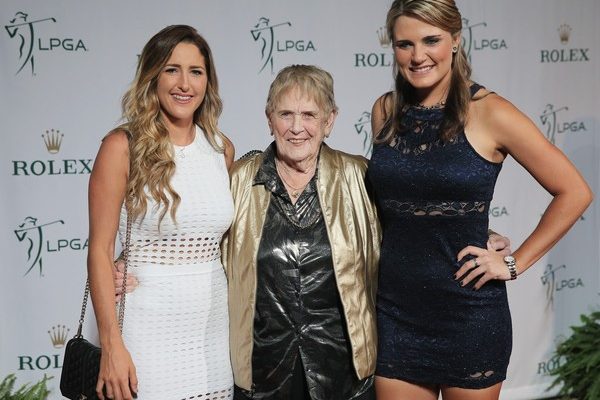Surely A Legend: Q&A With Shirley Spork

In her nonagenarian years, the legend of Shirley Spork continues to grow.
One of the 13 founding members of the Ladies Professional Golf Association (LPGA) in 1950, the Detroit, Michigan native and longtime Coachella Valley resident has seen her legacy deservedly expand in the past 18-months as the star of a hit documentary and author of a new book.
A driving force behind the creation of the LPGA’s Teaching and Club Pro Division, the 91-year-old Spork has always been an instructor at heart.
“What’s your favorite wedge?” she’s wont to ask, before advising, “The next time you practice, I want you to try and hit a short, medium and long shot with your 56-degree. If you accomplish that, let me know.”
Discussing “The Founders” film and her book, “From Green to Tee,” (both available via Amazon*) Spork made time for a Q & A with FORE Her.
FORE Her: You’re such a vital part of the past and present of women’s golf. What are your thoughts about the future of women’s golf?
Shirley Spork: “We’ve come up a great deal, and in the near future, you’re going to see it. The LPGA and USGA girls’ golf program has increased 700 percent in the last three-to-five years. Soon, these girls will be adults and they’ll be continuing on in their golf. I think you’ll see this bubble burst open, maybe even in the next five years.”
FORE Her: Along with continuing to grow the women’s game, where else could golf improve?
Spork: “I think there could be more emphasis on the senior golfer, to keep them in the game. I think the PGA and LPGA should be offering more assistance to keep seniors in the game, and that can be done very easily by giving some supervised practice and providing competition that may be 9-hole or even 6-hole competitions at their clubs.”
FORE Her: “The Founders,” documenting the inception of the LPGA, has been a festival hit since its 2016 release. To what do you attribute the accolades?
Spork: “The comments I hear is that people didn’t know how hard it was, why we were doing it and where did we think we were going with it. And it was very difficult for the producers to find a lot of history with the black and white footage (that exists). So, to project, to be up-to-date, they interviewed people that played after us to get their comments, and that’s what makes it so interesting. If it was just all black and white, I don’t think it would be a hit at all.”
FORE Her: The recent release of your book, “From Tee to Green,” has garnered equal praise. Any favorite playing stories from these pages?
Spork: “There was a tournament in Mount Clemens, Michigan at Hillcrest Country Club. There was a bridge between the 16th and 17th holes which collapsed because of a big gallery, and people fell in the river. So, we had to walk off the course, into a culvert and then onto the state highway to get over to the 18th hole because the event was televised.”
FORE Her: And a favorite teaching story from the book?
Spork: “My experience playing in Scotland in 1951, and giving an exhibition at St. Andrews. I was invited into the clubhouse; the first woman ever in the clubhouse. And then going into the boardroom and standing on the table and giving a pitching wedge lesson.”
FORE Her: You’ve given lessons to players all over the globe, from celebrities to professionals to club duffers. What’s your most memorable moment of golf instruction?
Spork: “I think it would be to a senior, male golfer. He came to me and wanted to be able to swing and hit the ball; he was so bad, he’d hit it backwards or underneath me. I told him that, ‘Our goal this is year is to try and play one hole of golf where you stay on your own fairway.’ After numerous lessons, he came back to me with a big smile and said, ‘I did it!’ That was such a great reward to both of us; we fought it out, struggled and created something that he enjoyed.”
FORE Her: In December of ’17, you received the “Heritage Award” from the SCPGA. Of all your accolades, of all your memorabilia, what piece stands out the most?
Spork: “It a letter ‘E.’ To me, it’s very important because when I was at Eastern Michigan University, which was then called Michigan State Normal Teacher’s College, and this is right after World War II, they had just started the National Collegiate Tournament for Women, held at Ohio State. In that era, women were not supposed to excel at individual sports. So, I went to the tournament and won. I went to back college and wasn’t honored. Sixty-seven years later, I got my ‘E,’ and I’ve got it in a frame which my picture on each side. They made a big deal of it – 67 years later!”
*Viewing note: To enjoy a live, theatrical screening of “The Founders,” regional moviegoers can see the film on the big screen on Jan. 25 at the Mary Pickford Theater in Cathedral City, CA; proceeds of the screening will go to benefit The First Tee of the Coachella Valley.










